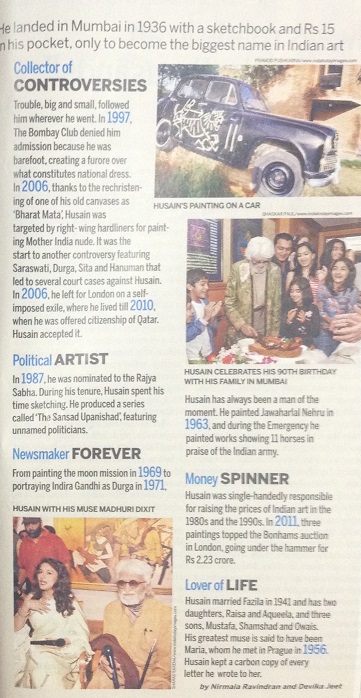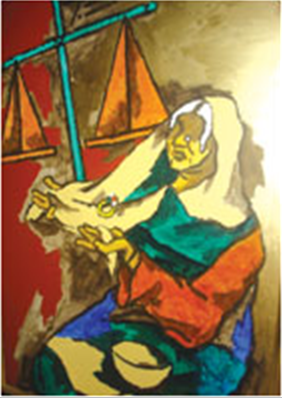Maqbool Fida (MF) Husain


This is a collection of articles archived for the excellence of their content. Readers will be able to edit existing articles and post new articles directly |
Contents |
Husain, Maqbool Fida
A meeting with a maestro
Art Modern Indian art Maqbool Fida Husain M.F. Husain
By Ali Adil Khan
If the great Mughal Emperor Akbar saw the collection of 51 large canvases created by Maqbool Fida Husain for the Mughal-i-Azam Museum in London, in all likelihood he would have bestowed the title of ‘Musavir-e-Azam’ on him.
I was fortunate to get the opportunity to preview these new works and meet one of the greatest artists of our time. Maqbool Fida Husain popularly known as M.F. Husain, who has just turned 92, was commissioned by Akbar Asif, son of K. Asif (director of the Indian epic film Mughal-i-Azam) to produce new works for the Mughal-i-Azam Museum which will be housed in his Park Lane penthouse.
As I arrived at the penthouse where Husain has set up his studio, I was greeted by Anjum Siddiqui an emerging artist, who was staying with Husain in transit to Delhi. She walked me to Husain’s studio, passing large finished and unfinished canvases. I was thrilled at the thought of meeting the maestro and seeing his studio for the first time.
Upon entering, I saw large paintings lined up all along the walls, and a few people sitting on comfortable leather sofa chairs. In the centre of the room was a large (10x10 feet) flexi-glass Italian coffee table scattered with books, exhibition brochures, and business cards. On a closer look, I noticed that the table had been painted and signed by Husain from underneath. I also noticed a white mattress and comforter placed on the floor next to the table where he probably rests. There were also two large easels, a step table with paint cans on it, and several paint brushes of various sizes.
However, Husain was not present in the studio. I was told that he was resting and had expressed an interest to paint that day provided there was the right audience and music. My friend Kamran Anwar, an investment banker and collector, who was accompanying me, offered to play a CD from a Qawwali album ‘Rung’ compiled by him, which he had brought to present to Husain. As the sound of Manzoor Niazi and party singing Meray banay ki baat na poocho, mera bana hariyala hai played, M. F. Husain made an entry into the studio. Everyone in the room rose to their feet. Tall and slim, dressed in a black kurta pajama with a white apron, he looked like he was in the mood to paint.
Beaming with energy, Husain commands great respect and adoration. As I greeted him he smiled and asked me to come and sit next to him. Enjoying the Qawwali, Husain gently started to clap. His persona was calm and quiet, gentle and composed. One feels very peaceful and relaxed in his company, despite his towering personality.
Later, he took me to preview his new works. About 30-35 paintings were complete, framed and ready for display; 5-10 seemed to be unfinished, and another 5-6 were blank canvases. All of these were the same size, roughly 8 ft x 5 ft. Some were painted in landscape and some in portrait. They were all creations of scenes from the film Mughal-i-Azam, as seen through the eyes of the maestro. Husain told me that this commission and body of work meant a lot to him as he had worked on the sets for the Mughal-i-Azam movie some 45 years ago.
The works were magnificent, characteristic of Husain’s style, executed in perfect light, form and colour. His masterly touch is evident from dexterous brush strokes and the use of vibrant and contrasting colours such as gold, silver, red, orange, blue and green. The series starts with a compelling painting of the map of Hindustan with Urdu writing “Main Hindustan hoon, Himalaya meri godh hai…….aur is ki tariqi main aik shaqs jis ka nam Jalaluddin Muhammad Akbar thaa…..”
“Every painting I am creating is my interpretation of the film and of history. The film had some great lines; hence many of the paintings have Urdu writings on them. These truly memorable lines are what the film is remembered for, and my art is a reflection of the film’s greatness,” he explained.
These paintings are also a tribute to the great Mughal King Akbar. “Beyond the film, Akbar was the most secular Mughal King ever, and in today’s time it is important to remember that. From his marriage to Jodhabai, the Rajput princess, to his laws and governance, he established greatness and secularity you seldom see, even in today’s modern times. My paintings reflect that,” he added.
Undoubtedly, the most precious thing for Husain is time — and he wants to make the best of it. He enjoys eating at the best restaurants, buying top quality clothes, and getting the best paints and hand made Italian frames for his works. The frames alone for the 51 paintings (the late K. Asif passed away at the age of 51) cost in excess of one hundred thousand pounds.
Wherever he goes he stands out in the crowd and gets stormed by his admirers for autographs. He signs his name very stylistically in English and Urdu and dates it as 007. He also very generously makes a small drawing of a horse (Duldul) or an elephant (Ganesh) for his admirers.
Mughal-i-Azam Museum is set to open before the end of this year, as soon as the 51 paintings are complete and hung with proper lighting. As for his next venture he informed that he will be making 99 paintings on Arab history in Qatar. These paintings will represent all religions, culture and people of the region.
At 92, Husain has amazing energy, drive and creativity. He speaks very little, probably conserving his energy for his art, but when he does speak, he is humorous, opinionated and full of ideas.
Since Husain cannot return to India due to the preposterous law suits filed against him — India’s loss is others gain. Artists of Husain’s calibre are born once in a few centuries. One of Allama Iqbal’s famous couplets aptly describes this great maestro “Hazaron saal nargis apni benoori pe roti hai — Bari musquil se hota hai chaman men deedawar paida.” (A thousand years Narcissus cries over its lacking / With difficulty is born one to behold)
Contribution
India Today, June 11, 2011
"His art was always made in an open studio, watched by thousands" M F Husain's death in exile is a tragic loss to India: Jitish Kallat
Jitish Kallat , The writer is an Indian artist who works in varied media
As told to Olina Banerji
The art scene that we have inherited is primarily because of the space M.F. Husain has carved for art for three decades prior to when my generation started exhibiting its work. He was responsible for uploading in the public consciousness the figure of the artist in post-Independence India. His death is a tragic loss; one thinks about the fact that he made art practically everyday and everywhere he went. It makes me think that were he healthy and alive today he would probably be holding a brush at this time. Equally one feels a deep sadness and anger when one thinks of the fact that he had to pass away in a foreign land and that his last years were shaped by the state's indifference in the face of many death threats he received from fundamentalist factions.
He was a man who was awarded a Padma Shri, a Padma Bhushan and a Padma Vibushan and yet in his last years the Indian state chose to honour him by exiling him; with his passing away we can't reverse the circumstances but there is much to introspect here. What does the last years of Husain's living in exile and his giving up the Indian citizenship mean for the nation and its position vis-a-vis culture? One also thinks about how rooted Husain's work was within the national context and how that umbilical cord was forcibly snapped. Yet Husain never allowed the tragedy to hold him back. He handled it with exemplary equanimity and an insightful sense of humsour. When he took up another nationality it almost seemed like he had simply returned the ball the Indian state had served him. His resolve to secure all his energy to carry on making art and not let these awful incidents overpower him is a lesson for all creative people.
His was a visual language that embraced the formal possibilities of European modernism and morphed it with the texture and essence of an emergent India immediately after Independence. Other artists of his generation shared some of these preoccupations but his art was always practised performatively, always involving an audience of thousands. It was made in an open studio, to be watched by the entire nation and the world. Now this is not how art is made normally and most artists would relish a certain solitude, to secure one's reflexivity, but most yardsticks of evaluating artistic practice seem inadequate to compute Husain's creative aspirations. He needs to be looked at as a legendary cultural figure rather than as a visual artist of genius.
Today anyone related to the arts anywhere, will feel a deep sense of loss. Two years ago, when my wife and I were checking out of a hotel in Mayfair, London, we bumped into a common friend Kalpana Shah of Tao Art Gallery. She told us Husain was also staying in the same hotel. As always his energy was infectious when he told us that he had been staying there for a while and had turned his suite into his studio for the rest of the summer. The ease with which he had transformed the space into a lush creative patch made us rethink what we do every day in our working lives. He did not appear like a person in exile. Here was a man who had taken full ownership of the place and time that he inhabited; a man who had learned how to fully seize the moment.
Prices fetched by Husain’s paintings
2020: Rs 13.4 crore for Battle of Ganga and Jamuna: Mahabharata 12’
NiMo’s Husain sets world record, March 6, 2020: The Times of India

From: NiMo’s Husain sets world record, March 6, 2020: The Times of India
Sale Of Fugitive’s Assets Raises ₹53.45Cr For ED
Jewellery tycoon Nirav Modi might be disgraced but the taint doesn’t seem to extend his art. In a two-day auction, collectors vied to snap up his seized assets which included a record-breaking M F Husain painting, Hermes handbags, a Rolls Royce Ghost and diamond-studded watches.
The Husain painting titled ‘Battle of Ganga and Jamuna: Mahabharata 12’ was the centerpiece of the live auction conducted by Saffronart on behalf of the Enforcement Directorate (ED) on Thursday. And it certainly lived up to its top billing, selling for Rs 13.4 crore and creating a new auction record for the artist. Another painting by Amrita Sher-Gil sold for even higher at Rs 15.6 crore. The live auction was preceded by an online auction. Both were described by Saffronart as “white glove sales”. In auction lingo, this means that all the items were sold. Not just sold, the two auctions raised a total of Rs 53.45 crore ($7.65 million) for the ED, crossing the pre-auction estimate of Rs 41 crore.
The diamantaire’s flashy lifestyle was evident in the objects on the block. Among the luxury collectibles was Modi’s Rolls-Royce Ghost which sold for Rs 1.68 crore. Saffronart CEO Dinesh Vazirani said “The frenzied bidding on watches, handbags and cars – most of which sold in multiples of their estimates – underscores the thriving market for luxury collectibles,”. TNN

